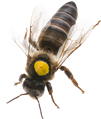WELCOME TO
HONNINGHUSET EJER BAVNEHØJ
Honninghuset Ejer Baunehøj, a professional beekeeping business, was established in 2007. Our beekeeping consists of about 250 bee hives. We sell high-quality queen bees and tasteful honey. We have apiaries in the area around Ejer Bjerge, south of Skanderborg, Denmark.
The apiaries are located in species-rich areas of natural beauty to give the bees the best living conditions. About 2/3 of our bees are used in our breeding programme for the selection and breeding of queen bees.
The company has a green profile and green operation, focusing exclusively on the use of biological treatment of the bees, and the wax comes from a “green” wax pool.
My name is Jakob Germundsson. Since the early 1990s, I have been fascinated by bees and their amazing life. At the beginning my beekeeping consisted of two bee hives, but over the years, it has developed significantly. My hobby has become my way of life, and I have been a full-time beekeeper since 2015.













.jpg?height=340&width=480&ticks=1549537408)
